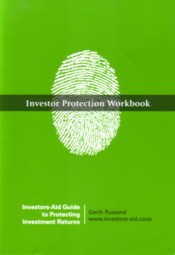A Helping Hand for Canadian Investors
Last October, a few months before launching this blog, I became a member of the Investors-Aid Co-operative of Canada. Based in Vancouver, the Co-op is a national consumer organization whose mission is “to provide members education, publications, online tools, and discounts that help ensure low investment costs and fair returns.” I joined because I wanted [...]
 If you decide to join, I would definitely recommend getting the books. In the Investor Protection Workbook, Rustand begins by explaining why “investing is a consumer’s nightmare.” He shows why trying to time the market and chase performance are dangerous, and why indexing usually beats active management over the long term. He then helps investors determine their risk tolerance and shows how that’s related to choosing the right asset allocation. Finally, he offers several low-cost model portfolios designed for capital preservation, income, balanced investing and aggressive growth.
I have just one issue with the advice in the workbook. I appreciate that many of the Co-op’s members are seniors looking for safety and income, and that most are inexperienced investors. But in a section is called “High Risk = Low Returns,” Rustand argues that asset classes “such as Asian, emerging markets, or precious metals tend to have low long-term returns compared with less risky alternatives.” This simply isn’t true — indeed, it goes against the fundamental tenet of investing that risk and reward are intimately related. (Emerging markets are certainly volatile, but they have delivered annualized returns over 12% since 1988, compared with less than 9% for Canadian equities.) The book advises investors to completely avoid European and Asian markets — developed and emerging — as well as US small caps. While these investments may be inappropriate for some investors, it’s misleading to suggest that they deliver poor returns.
One other quibble is that the workbook uses the outdated term “index unit” rather than “exchange-traded fund.” This seems likely to confuse inexperienced investors, many of whom will have heard about ETFs in the media and may be seeking more information about them.
Those reservations aside, the Investor Protection Workbook is filled with prudent and practical advice for investors who have decided to take control of their own finances. Garth Rustand has generously provided me with a copy, and I will send the book to one reader who posts a comment below, or who Tweets this post.
If you decide to join, I would definitely recommend getting the books. In the Investor Protection Workbook, Rustand begins by explaining why “investing is a consumer’s nightmare.” He shows why trying to time the market and chase performance are dangerous, and why indexing usually beats active management over the long term. He then helps investors determine their risk tolerance and shows how that’s related to choosing the right asset allocation. Finally, he offers several low-cost model portfolios designed for capital preservation, income, balanced investing and aggressive growth.
I have just one issue with the advice in the workbook. I appreciate that many of the Co-op’s members are seniors looking for safety and income, and that most are inexperienced investors. But in a section is called “High Risk = Low Returns,” Rustand argues that asset classes “such as Asian, emerging markets, or precious metals tend to have low long-term returns compared with less risky alternatives.” This simply isn’t true — indeed, it goes against the fundamental tenet of investing that risk and reward are intimately related. (Emerging markets are certainly volatile, but they have delivered annualized returns over 12% since 1988, compared with less than 9% for Canadian equities.) The book advises investors to completely avoid European and Asian markets — developed and emerging — as well as US small caps. While these investments may be inappropriate for some investors, it’s misleading to suggest that they deliver poor returns.
One other quibble is that the workbook uses the outdated term “index unit” rather than “exchange-traded fund.” This seems likely to confuse inexperienced investors, many of whom will have heard about ETFs in the media and may be seeking more information about them.
Those reservations aside, the Investor Protection Workbook is filled with prudent and practical advice for investors who have decided to take control of their own finances. Garth Rustand has generously provided me with a copy, and I will send the book to one reader who posts a comment below, or who Tweets this post.











